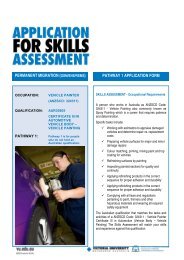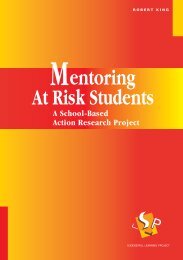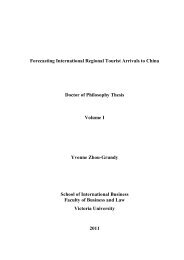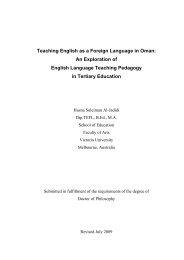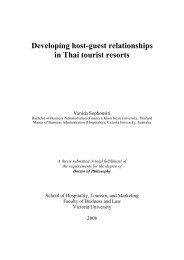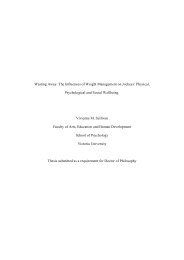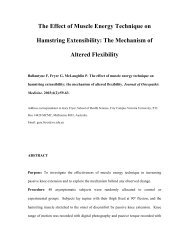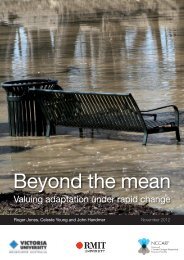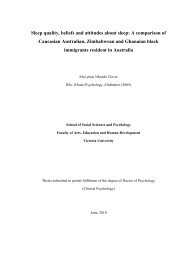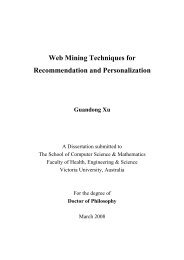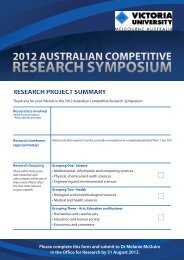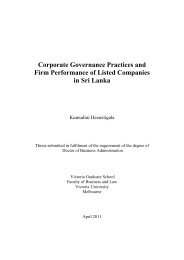UNDERGRADUATE AND TAFE COURSE GUIDE - Victoria University
UNDERGRADUATE AND TAFE COURSE GUIDE - Victoria University
UNDERGRADUATE AND TAFE COURSE GUIDE - Victoria University
Create successful ePaper yourself
Turn your PDF publications into a flip-book with our unique Google optimized e-Paper software.
VICTORIA UNIVERSITY<br />
QUALIFICATIONS<br />
We offer courses in vocational and further education (<strong>TAFE</strong>) and higher education. Because we offer so many options, it’s easy<br />
for you to journey from <strong>TAFE</strong> to a degree, and on to postgraduate studies. You could start with a certificate course and end with<br />
a Masters or PhD. We give you a world of options.<br />
QUALIFICATION DURATION*<br />
VETiS<br />
Offered by VU College and Vocational Education and Training in Schools (VETiS). For students in years 10, 11 and 12, including<br />
VCE VET, VET, Australian School-Based Apprenticeships and short courses. For more information email vetis@vu.edu.au or visit<br />
www.vu.edu.au/vetis<br />
FURTHER <strong>AND</strong> VOCATIONAL EDUCATION (<strong>TAFE</strong>)<br />
certificates i–iV<br />
Training ranges from basic skills to trade and post-trade qualifications.<br />
Students who complete an Australian Apprenticeship will receive a qualification.<br />
Diploma and advanced diploma<br />
Provide students with the knowledge and skills necessary to work in many professions.<br />
HIGHER EDUCATION – <strong>UNDERGRADUATE</strong><br />
associate degree<br />
Similar to an advanced diploma but focus more on academic theory rather than industry-specific workplace knowledge.<br />
bachelor degree<br />
Provide students with knowledge and skills for work in their chosen profession and initial preparation for postgraduate study.<br />
honours degree<br />
An additional year of study with supervised research experience. Available to students who achieve consistently high results in their<br />
undergraduate degree.<br />
combined and joint degrees<br />
Combined degrees combine the core components of two disciplines into a single program of study. The student receives two<br />
degrees. Joint degrees integrate two degrees, run independently by two schools, departments or faculties. The student receives a<br />
single degree.<br />
HIGHER EDUCATION – POSTGRADUATE<br />
Graduate certificate and graduate diploma<br />
Improves your professional practice and extends your skills and knowledge from your bachelor degree or advanced diploma.<br />
Develops professional competence in new areas.<br />
master and doctoral degrees<br />
Master degrees are studies in a specific area through coursework and/or research. Doctorates are the highest levels of academic<br />
achievement and require an original contribution of knowledge, usually through a thesis.<br />
5 days (short courses and tasters)<br />
to 2 years full time (apprenticeships).<br />
6 months – 4 years full time<br />
18 months – 2 years full time<br />
2 years full time<br />
3 – 5 years full time<br />
1 year full time<br />
Combined degree: 4 – 5 years full time<br />
Joint degree: 3 – 4 years full time<br />
6 months – 1 year full time<br />
2 – 3 years full time<br />
*Study durations are a guide only. You may choose to study part time. This table includes excerpts from the Department of Education, Employment and Workplace Relations’ website: www.jobguide.thegoodguides.com.au<br />
8 for more Details about courses Visit www.Vu.eDu.au/courses



